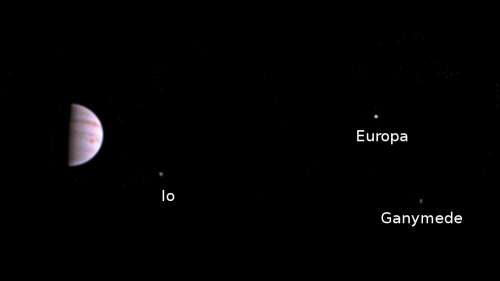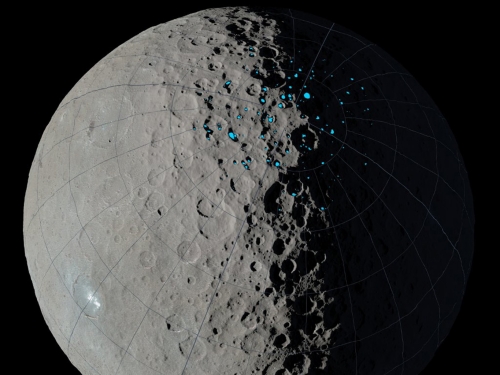We don’t have high-resolution pictures of Jupiter from the Juno mission yet, but we do have JunoCam in operation. It’s a color camera working in visible light that has returned data following the spacecraft’s arrival at Jupiter on July 4. This JPL news release tells us that JunoCam was folded into the mission as part of NASA’s public outreach. It is not, in other words, considered a science instrument, and we’ll need to wait until late August for the first high-resolution images. Still, it’s satisfying to see that all is apparently well in Jupiter space.

Image: This color view from NASA’s Juno spacecraft is made from some of the first images taken by JunoCam after the spacecraft entered orbit around Jupiter on July 5th (UTC). The view shows that JunoCam survived its first pass through Jupiter’s extreme radiation environment, and is ready to collect images of the giant planet as Juno begins its mission. Credit: NASA/JPL-Caltech/SwRI/MSSS.
Here we’re about 4.3 million kilometers from Jupiter on the outbound leg of the initial 53.5-day capture orbit, a view that yields atmospheric features including the Great Red Spot, along with three of the Galilean moons. Io, Europa and Ganymede appear from left to right in the image. Bear in mind that as the mission progresses, Juno will at times close to within 4100 kilometers of the cloud tops. Spectacular high-resolution views are ahead.
The View from Ceres
We might well find ice deposits on the surface of Ceres. That’s the word from researchers with the Dawn mission, who have been looking at permanently shadowed areas on the dwarf planet. Areas like these are generally on a crater floor or along a part of the crater wall facing the pole. With temperatures below -151 degrees Celsius (122 K) these areas become cold traps, where water ice can accumulate and remain stable for a billion years.
“The conditions on Ceres are right for accumulating deposits of water ice,” said Norbert Schorghofer, a Dawn guest investigator at the University of Hawaii at Manoa. “Ceres has just enough mass to hold on to water molecules, and the permanently shadowed regions we identified are extremely cold — colder than most that exist on the moon or Mercury.”

Image: At the poles of Ceres, scientists have found craters that are permanently in shadow (indicated by blue markings). Such craters are called “cold traps” if they remain below about minus 151 degrees Celsius. These shadowed craters may have been collecting ice for billions of years because they are so cold. Credit: NASA/JPL-Caltech/UCLA/MPS/DLR/IDA.
Using computer modeling in conjunction with Dawn’s camera imagery, Schorghofer and colleagues could analyze surface features in great detail, learning which areas receive direct sunlight and how changes during the course of a year on Ceres (1680 days) affect the solar radiation reaching the surface. Dozens of permanently shaded regions turned up in the northern hemisphere, the largest (inside a 16-kilometer crater) less than 65 kilometers from the north pole. Altogether, these regions make up about 1800 square kilometers.
As opposed to the Moon and Mercury (which, like Ceres, have a very small spin axis tilt, or obliquity), the cold trap regions on Ceres extend much further toward the equator. The permanently shadowed regions have to be close to the poles on the Moon and Mercury to get cold enough for ice to remain stable. But like Mercury, these areas account for about the same fraction — less than one percent — of the surface area of the northern hemisphere, and most of these areas on Ceres are cold enough to serve as efficient cold traps for water ice.
All of this has useful implications if we’re thinking ahead to one day exploiting Ceres’ resources:
“While cold traps may provide surface deposits of water ice as have been seen at the moon and Mercury, Ceres may have been formed with a relatively greater reservoir of water,” said Chris Russell (UCLA), principal investigator of the Dawn mission. “Some observations indicate Ceres may be a volatile-rich world that is not dependent on current-day external sources.”
It’s also interesting to note that we don’t know the origin of the ice in the cold traps of either Mercury or the Moon. A possible source is incoming comets, meteorites or interplanetary dust particles, but as the paper on this work notes, we might also find ice generated from solar wind interactions (a mechanism not fully understood) or even outgassing. We would expect, however, that solar wind-generated water resources would be less common with greater distance from the Sun, while infalling H2O would be higher on Ceres than on Mercury because of Ceres’ location in the asteroid belt. Which leads us, the paper notes, to a way to investigate further:
…the trapping efficiency on Mercury and Ceres are similar; that is, for the same number of generated water molecules per surface area, the thickness of the ice accumulating in the cold traps should be almost as high on Ceres than on Mercury. Hence, significant differences in the thickness of young ice deposits may reveal the main source of water. A lack of ice deposits in Cerean cold traps would suggest that infall is not a major source of this ice, consistent with a solar wind generation mechanism on Mercury.
We can, the paper argues, expect fresh and perhaps optically bright ice deposits in the cold traps of Ceres, even without any further water delivery. The authors calculate that about 1 out of every 1000 water molecules generated on the surface of Ceres will wind up in a cold trap during a Cerean year. The upshot: Thin but detectable ice deposits over a 100,000 year period.
The paper is Schorghofer et al., “The permanently shadowed regions of dwarf planet Ceres,” Geophysical Research Letters 6 July 2016 (full text). A JPL news release is also available.



Cold traps are certainly cold enough to keep ice, but for billions of years? Is Ceres stable in its orbit, axial inclination etc for such long periods?
Does it need to be? Recent impactors could top up the water in the traps. Maybe just a few million years?
Good point. Did you mean by causing eruption from Ceres itself, or from the impactor, or both?
My point was mire about billion-year old water, though.
Michael T
The impact heat would melt the ice and probably vaporize some of it too. That would allow water to migrate to the surface. Some of the vaporized water would find its way to the cold traps. It wouldn’t surprise me if Occator crater was an impact site and that the salts we see on the surface are the evaporites from meltwater erupting onto the surface.
If the impactor was a comet or water-rich asteroid, then some of the water could come from this body. But given Ceres composition, I have to think that most water on the surface comes from Ceres itself. As we so many questions about the solar system, we need analyses done with samples taken in situ, whether analyzed locally or back on Earth.
What’s really great about the imagery from the Juno spacecraft is the fact that you clearly see the Terminator line in the picture indicating the fact that the spacecraft’s orbital plane is in fact aligned with Jupiter’s spin axis.
That would be the expectation since you have a polar orbit; my understanding is that the orbit is highly elliptical and that in his supposed to stay in its orbit for about two Earth years. Such a orbital plane would be expected to be static with respect to the distant stars and that would allow the solar panels to receive sunlight for its 20 month expected mission.
Otherwise, if it went on longer than that the spacecraft’s orbital plane would be partially behind Jupiter and put the solar panels into the planet’s shadow.
The way it stands now, the spacecraft can look down upon the polar regions while retaining orientation of its solar panels in the bright sunshine to keep up power. Thus, the length of the mission is only going to be for about one sixth of Jupiter’s year. Figured it out pretty good, didn’t they ?
Ceres has at least one active cryovolcano:
https://asunow.asu.edu/20160901-ceres-asu-tiny-world-where-volcanoes-erupt-ice
http://www.psi.edu/news/2ceres
To quote:
“For the first time, a carbon-rich asteroid has been observed in the spectral region where graphitized carbons show unique spectral features,” said Hendrix. “Other dark asteroids probably have graphitized carbon on their surfaces as well.”
“This is a window to evidence of the effects caused by direct exposure to space for a primitive asteroid surface,” said Vilas.
Apparently it was rather difficult for these scientists to just say that Ceres has active volcanoes that spew ice, even with all the scientific evidence they collected.
Higher Dawn orbit produces breathtaking new images of Ceres
November 21, 2016
Laurel Kornfeld
NASA’s Dawn spacecraft, now in a higher orbit around Ceres, captured breathtaking new views of the dwarf planet, including one of Occator Crater which is the site of the uncanny bright spots that have intrigued scientists for more than a year and a half.
The Dawn team released the new images, along with a processed one that shows how Ceres would appear in color when viewed up close by the naked eye.
For its fifth science orbit, Dawn spiraled from close-in to about 920 miles (1,480 kilometers) above the surface in early October, where its instruments imaged Occator Crater from a position in which the angle of the Sun is different than it has been in any earlier photos.
Full article here:
http://www.spaceflightinsider.com/missions/solar-system/higher-dawn-orbit-produces-breathtaking-new-images-ceres/
Dawn Journal: Maneuvering for Science
Posted by Marc Rayman
2016/11/29 16:24 UTC
Topics: mission status, asteroids, Dawn, asteroid 1 Ceres
Dear Decadawnt Readers,
Blue rope lights adorn Dawn mission control at JPL, but not because the flight team is in the holiday spirit (although they are in the holiday spirit). The felicitous display is more than decorative. The illumination indicates that the interplanetary spacecraft is thrusting with one of its ion engines, which emit a lovely, soft bluish glow in the forbidding depths of space. Dawn is completing another elegant spiral around dwarf planet Ceres, maneuvering to its sixth science orbit.
Dawn’s ion propulsion system has allowed the probe to accomplish a mission unlike any other, orbiting two distant extraterrestrial destinations. Even more than that, Dawn has taken advantage of the exceptional efficiency of its ion engines to fly to orbits at different altitudes and orientations while at Vesta and at Ceres, gaining the best perspectives for its photography and other scientific investigations.
Full article here:
http://www.planetary.org/blogs/guest-blogs/marc-rayman/20161129-dawn-journal-maneuvering-for-science.html